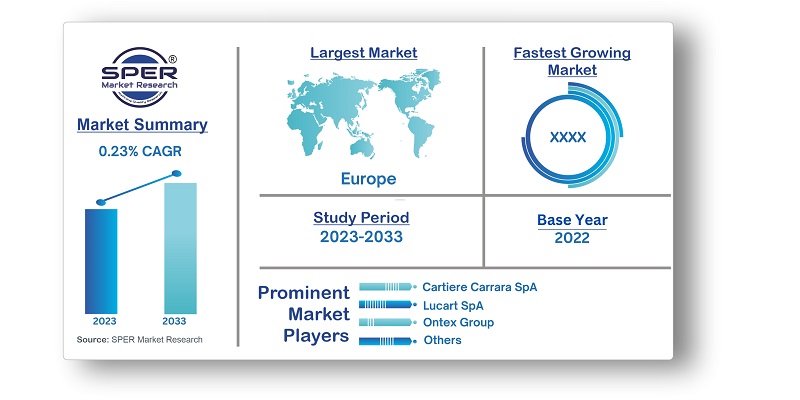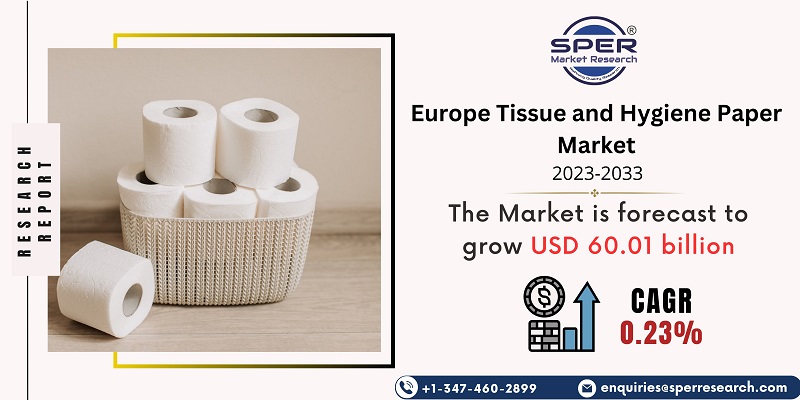
Europe Tissue and Hygiene Paper Market Growth, Size, Trends, Revenue, Share and Future Scope
Europe Tissue and Hygiene Paper Market Size- By Product Type, By Raw Material, By Cosmetic Type- Regional Outlook, Competitive Strategies and Segment Forecast to 2033
| Published: Sep-2023 | Report ID: FMCG2398 | Pages: 1 - 153 | Formats*: |
| Category : Consumer & Retail | |||
- August 2022: The WEPA Group has made an investment in a cutting-edge converting line at its Leuna facility, which has recently begun operation. This advanced line, designed by Gambini, produces soft and absorbent paper with minimal raw material usage, primarily targeting kitchen towels, and achieves speeds of 700 meters per minute.
- May 2021: Sofidel Group launched a novel product called Nicky Defend. This innovative offering is a disposable paper towel infused with antibacterial lotion, designed to promote personal hygiene in both workplace and household settings.


| Report Metric | Details |
| Market size available for years | 2019-2033 |
| Base year considered | 2022 |
| Forecast period | 2023-2033 |
| Segments covered | By Product Type, By Raw Material, By Type |
| Regions covered | Denmark, Finland, France, Germany, Ireland, Italy, Netherlands, Norway, Spain, Sweden, Switzerland, United Kingdom and rest of Europe |
| Companies Covered | Cartiere Carrara SpA, Essity AB, Industrie Cartarie Tronchetti SpA, Kimberly-Clark Corporation, Lucart SpA, Metsa Group, Ontex Group, Renova, Sofidel Group, WEPA Industrieholding SE, Others |
- Environmental and Health-conscious Consumers
- Food Service Industry
- Government and Non-Profit Organizations
- Healthcare Facilities
- Households
- Industrial and Manufacturing Sector
- Janitorial and Cleaning Services
- Parents and Caregivers
- Retailers
- Schools and Educational Institutions
- Travel and Hospitality Industry
- Others
| By Product Type: |
|
| By Raw Material: |
|
| By Type: |
|
- Europe Tissue and Hygiene Paper Market Size (FY’2023-FY’2033)
- Overview of Europe Tissue and Hygiene Paper Market
- Segmentation of Europe Tissue and Hygiene Paper Market By Product Type (Baby Diapers, Feminine Hygiene, Household Paper, Incontinence, Paper Tissues, Toilet Paper)
- Segmentation of Europe Tissue and Hygiene Paper Market By Raw Material (Kraft, Recycled, Sulfite, Other Raw Materials)
- Segmentation of Europe Tissue and Hygiene Paper Market By Type (At Home, Away from Home)
- Statistical Snap of Europe Tissue and Hygiene Paper Market
- Expansion Analysis of Europe Tissue and Hygiene Paper Market
- Problems and Obstacles in Europe Tissue and Hygiene Paper Market
- Competitive Landscape in the Europe Tissue and Hygiene Paper Market
- Impact of COVID-19 and Demonetization on Europe Tissue and Hygiene Paper Market
- Details on Current Investment in Europe Tissue and Hygiene Paper Market
- Competitive Analysis of Europe Tissue and Hygiene Paper Market
- Prominent Players in the Europe Tissue and Hygiene Paper Market
- SWOT Analysis of Europe Tissue and Hygiene Paper Market
- Europe Tissue and Hygiene Paper Market Future Outlook and Projections (FY’2023-FY’2033)
- Recommendations from Analyst
1.1. Scope of the report1.2. Market segment analysis
2.1. Research data source2.1.1. Secondary Data2.1.2. Primary Data2.1.3. SPER’s internal database2.1.4. Premium insight from KOL’s2.2. Market size estimation2.2.1. Top-down and Bottom-up approach2.3. Data triangulation
4.1. Driver, Restraint, Opportunity and Challenges analysis4.1.1. Drivers4.1.2. Restraints4.1.3. Opportunities4.1.4. Challenges4.2. COVID-19 Impacts of the Europe Tissue and Hygiene Paper Market
5.1. SWOT Analysis5.1.1. Strengths5.1.2. Weaknesses5.1.3. Opportunities5.1.4. Threats5.2. PESTEL Analysis5.2.1. Political Landscape5.2.2. Economic Landscape5.2.3. Social Landscape5.2.4. Technological Landscape5.2.5. Environmental Landscape5.2.6. Legal Landscape5.3. PORTER’s Five Forces5.3.1. Bargaining power of suppliers5.3.2. Bargaining power of buyers5.3.3. Threat of Substitute5.3.4. Threat of new entrant5.3.5. Competitive rivalry5.4. Heat Map Analysis
6.1. Europe Tissue and Hygiene Paper Market Manufacturing Base Distribution, Sales Area, Product Type6.2. Mergers & Acquisitions, Partnerships, Product Launch, and Collaboration in Europe Tissue and Hygiene Paper Market
7.1. Europe Tissue and Hygiene Paper Market Value Share and Forecast, By Product Type, 2023-20337.2. Baby Diapers7.3. Feminine Hygiene7.4. Household Paper7.5. Incontinence7.6. Paper Tissues7.6.1. Bathroom Tissues7.6.2. Paper Napkins7.6.3. Paper Towels7.6.4. Facial Tissues7.6.5. Specialty and Wrapping Tissues7.7. Toilet Paper
8.1. Europe Tissue and Hygiene Paper Market Value Share and Forecast, By Raw Material, 2023-20338.2. Kraft8.3. Recycled8.4. Sulfite8.5. Other Raw Materials
9.1. Europe Tissue and Hygiene Paper Market Value Share and Forecast, By Type, 2023-20339.2. At Home9.3. Away from Home
10.1. Europe Tissue and Hygiene Paper Market Size and Market Share
11.1. Europe Tissue and Hygiene Paper Market Size and Market Share By Product Type (2019-2026)11.2. Europe Tissue and Hygiene Paper Market Size and Market Share By Product Type (2027-2033)
12.1. Europe Tissue and Hygiene Paper Market Size and Market Share By Raw Material (2019-2026)12.2. Europe Tissue and Hygiene Paper Market Size and Market Share By Raw Material (2027-2033)
13.1. Europe Tissue and Hygiene Paper Market Size and Market Share By Type (2019-2026)13.2. Europe Tissue and Hygiene Paper Market Size and Market Share By Type (2027-2033)
14.1. Europe Tissue and Hygiene Paper Market Size and Market Share By Region (2019-2026)14.2. Europe Tissue and Hygiene Paper Market Size and Market Share By Region (2027-2033)14.3. Denmark14.4. Finland14.5. France14.6. Germany14.7. Ireland14.8. Italy14.9. Netherlands14.10. Norway14.11. Spain14.12. Sweden14.13. Switzerland14.14. United Kingdom14.15. Rest of Europe
15.1. Cartiere Carrara SpA15.1.1. Company details15.1.2. Financial outlook15.1.3. Product summary15.1.4. Recent developments15.2. Essity AB15.2.1. Company details15.2.2. Financial outlook15.2.3. Product summary15.2.4. Recent developments15.3. Industrie Cartarie Tronchetti SpA15.3.1. Company details15.3.2. Financial outlook15.3.3. Product summary15.3.4. Recent developments15.4. Kimberly-Clark Corporation15.4.1. Company details15.4.2. Financial outlook15.4.3. Product summary15.4.4. Recent developments15.5. Lucart SpA15.5.1. Company details15.5.2. Financial outlook15.5.3. Product summary15.5.4. Recent developments15.6. Metsa Group15.6.1. Company details15.6.2. Financial outlook15.6.3. Product summary15.6.4. Recent developments15.7. Ontex Group15.7.1. Company details15.7.2. Financial outlook15.7.3. Product summary15.7.4. Recent developments15.8. Renova15.8.1. Company details15.8.2. Financial outlook15.8.3. Product summary15.8.4. Recent developments15.9. Sofidel Group15.9.1. Company details15.9.2. Financial outlook15.9.3. Product summary15.9.4. Recent developments15.10. WEPA Industrieholding SE15.10.1. Company details15.10.2. Financial outlook15.10.3. Product summary15.10.4. Recent developments15.11. Others
SPER Market Research’s methodology uses great emphasis on primary research to ensure that the market intelligence insights are up to date, reliable and accurate. Primary interviews are done with players involved in each phase of a supply chain to analyze the market forecasting. The secondary research method is used to help you fully understand how the future markets and the spending patterns look likes.
The report is based on in-depth qualitative and quantitative analysis of the Product Market. The quantitative analysis involves the application of various projection and sampling techniques. The qualitative analysis involves primary interviews, surveys, and vendor briefings. The data gathered as a result of these processes are validated through experts opinion. Our research methodology entails an ideal mixture of primary and secondary initiatives.



Frequently Asked Questions About This Report
PLACE AN ORDER
Year End Discount
Sample Report
Pre-Purchase Inquiry
NEED CUSTOMIZATION?
Request CustomizationCALL OR EMAIL US
100% Secure Payment






Related Reports
Our Global Clients
Our data-driven insights have influenced the strategy of 200+ reputed companies across the globe.




















